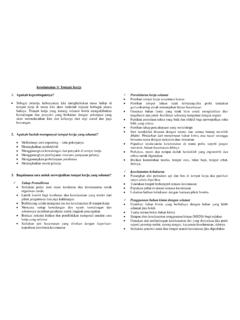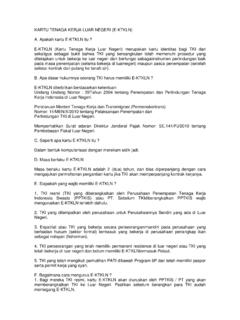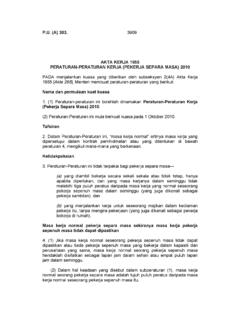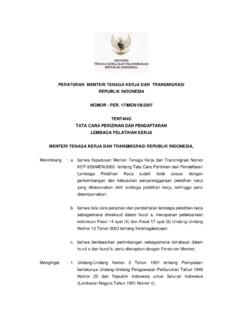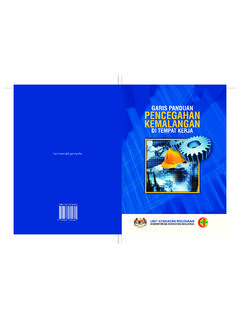Transcription of SOVIET PRISON CAMPS AND THEIR LEGACY - Gulag
1 Gulag : SOVIET PRISON CAMPS AND THEIR LEGACYBy David Hosford, Pamela Kachurin and Thomas LamontA Project of the National Park Service and the National Resource Center for Russian, East Europeanand Central Asian Studies, Harvard UniversityNAMEThe authors would like to thankthe National Park Service andthe Bradley Foundation forunderwriting this important project. We would like to personally thank Martin Blatt,Louis Hutchins, and KathyTevyaw of the National ParkService for THEIR assistance and insight. Special thanks toMary Giles, for her alwayscheerful curriculum unit is dedi-cated to all those imprisoned in the Gulag 1 Content Essay:1 The Establishment and Scope of the Gulag System Day 1 Class Exercises and Homework12 Day 2 Content Essay:15 Daily Life in the CampsDay 2 Class Exercises and Homework28 Day 3 Content Essay:33 Coming to Terms with the Gulag Then and NowDay 3 Class Exercises and Homework42 Biographical Sketches43 Appendix:Excerpt from Dr. Jerzy Gliksman s Testimony 53to the United NationsAdditional Resources for Teaching the GULAG58 TABLEOF CONTENTSNUMBERS DEBATEA 1990 report by the MoscowNews stated that between 1931 and 1953, 3,778,234 people were arrested for counter-revolutionary and state crimes,of which 786,098 were shot.
2 *Recent scholarship suggests that between 1929 and 1953, 18 million people passed through CAMPS and 6 millionmore were : Moskovskie Novosti(Moscow News), March 4, OF Gulag :State Camp AdministrationNAMEGULAG: SOVIET PRISON CAMPS AND THEIR LEGACY DAY ONE1 Gulag : SOVIET PRISON CAMPS AND THEIR LEGACYMost countries have PRISON systems where those convicted of crimes serve out THEIR of these countries believe that people who commitcrimes should be punished by being separated from therest of society and deprived of some of THEIR , the Gulag the PRISON camp system that arose in the SOVIET Union after 1929 served primarily as a way to gain control over the entire population, ratherthan punish criminal acts. The incarceration of millionsof innocent people in the Gulag system is correctly seenas one of the worst and most shocking episodes of thetwentieth century. Gulag locations across SOVIET Union*NAMEGULAG: SOVIET PRISON CAMPS AND THEIR LEGACY DAY ONE2 TIMELINE17th-20th centuries:forced labor brigades in SiberiaAugust 1918:Vladimir Lenin orders Kulaks (wealthierpeasants), priests, and other unreliables to be locked upin a concentration camp outside of town Sept.
3 1918:Red Terror initiated by Lenin: Arrest and incarceration of Landowners, industrialists, merchants,priests and anti- SOVIET officers all to be detained in concentration campsDecember 1919:21 registered concentration campsDecember 1920:107 registered concentration camps1923:Solovetsky monastery in northwestern Russia turned over to OGPU (precursor of NKVD and KGB) for use as a PRISON campNovember 1925:Decision to make systematic use of PRISON labor out of economic necessity, and for large scale construction projects1929:Decision to create mass camp system as an elementin transforming SOVIET Union into industrialized country1930-1933:Two million Kulaks exiled to Siberia, Kazakhstanand other remote regions1930: 179,000 people in PRISON camps1931:212,000 people in PRISON camps1932-1933: White Sea Canal camp set up to constructcanal connecting inland waterways with White Sea1934: CAMPS expand into Far Eastern Siberia and Kazakhstan1934:510,307 people in PRISON camps1937-1938:Great Terror: one in every twenty people inSoviet Union arrested1938: 1,888,571 people in PRISON CAMPS (in addition, a great many more people were executed)Beria replaces Yezhov1939: CAMPS in almost every region, in every time zone inSoviet Union1,672,992 people in PRISON campsJuly 1941-1944:Mass Amnesties: 975,000 prisonersreleased into Red Army over three years1945:1,460,677 people in PRISON camps1950: PRISON population reaches its highest levels: 2,525,146 people in PRISON campsMarch 5, 1953:Death of Stalin2,468,524 people in PRISON campsMarch 27, 1953:Amnesty for prisoners with less than fiveyear sentences, pregnant women, women with children, all children under eighteen One million people releasedDecember 1953:Beria executed1954:Many restrictions lifted on prisoners remaining inGULAG system: could receive mail and buy clothing1956:Khrushchev s Secret Speech acknowledges excesses of Stalin and his associates1950s:Arrests of dissidents continues.
4 Some are in CAMPS ,some in psychiatric hospitals1986: Gorbachev issues general pardon for all political prisoners and prisons shut down for good1995: Gulag Museum opens at site of Perm-36 PRISON CampMillions of innocent people were incarcerated in theGULAG, serving sentences of five to twenty years ofhard labor. Prisoners in CAMPS worked outdoors and inmines, in arid regions and the Arctic Circle, withoutadequate clothing, tools, shelter, food, or even cleanwater. We will never know how many prisoners sufferedfrom starvation, illness, violence, and cold; an immensenumber of people died. More people passed through theGULAG, for a much longer period of time, than throughNazi concentration CAMPS ; yet, the Gulag is still notnearly as well Nazi concentration CAMPS and the Gulag differ in a very important way. Nazi CAMPS were used to exterminate whole groups of people, most notably theJewish population of Europe. The Gulag was used as a weapon of ongoing political control over one Gulag system did not target any particular groupof people: in fact all ethnic groups, nationalities and religions were imprisoned.
5 Moreover, if a prisoner managed to somehow survive his or her sentence, he or she would be released at the end of it. There were no plans for releasing any of the prisoners of Nazi concentration order to answer the difficult question of how thiscould happen, we must examine the leadership of theSoviet Union, with Joseph Stalin at its STALIN AND HIS RISE TO POWERJ oseph Stalin, born Iosef Dzhugashvili, in the country of Georgia, did not start out as a central player in theevents leading up to the Bolshevik Revolution in Lenin appointed him as the editor of Pravda,the newspaper of the Communist Party, and then asCommissar of Nationalities in November 1917. In 1922,having become an important person in Lenin s inner circle, he was appointed to the position of GeneralSecretary of the Communist Party. Yet Lenin expressedapprehension that Stalin would abuse his power if heremained in this position. In his Testament written in1922, Lenin wrote Stalin, having become GeneralSecretary, has unlimited authority concentrated in hishands and I am not sure whether he will always be capable of using that authority with sufficient caution.
6 1 Indeed, by the time of Lenin s death two years later,Stalin had transformed his position into the most powerful post in the country. By 1928, Stalin had complete control of the CommunistParty and had appointed only those people who were personally loyal to him to run the most important government departments. From this position of power,Stalin and his economic planners began the transforma-tion of the primarily agricultural SOVIET Union into an industrialized state, with the first Five Year Plan. Theexpectations of what could be produced were completelyunrealistic, and those factory managers and workers who could not produce the minimum quotas wereaccused of sabotage and wrecking. Gulag : SOVIET PRISON CAMPS AND THEIR LEGACY DAY ONE3 NAMEV ladimir Lenin and Joseph Stalin(right), 1922. Stalin publicized thisphotograph to prove that Lenin trusted and supported StalinCourtesy of the Library of CongressCourtesy of the Library of CongressCAMPAIGNS AGAINST ENEMIES OF THE PEOPLE 1930-1933: Campaigns against the Kulaks.
7 Beginning in 1930, peasants were arrested or sent intoexile, or immediately shot on the suspicion of being ene-mies of the people. Peasants were required to turn allgrain over to the state; anyone in possession of graincould be accused of hoarding. Others might be labeled Kulaks; the word means fist, but could be used toaccuse any peasant of non- SOVIET methods simplybecause his personal crops or livestock were could be judged simply because they owned anextra cow; a jealous neighbor could accuse them of beinganti- SOVIET . Between 1930 and 1933, over two millionpeasants were exiled to Siberia and 100,000 more weresentence to the : Kirov Affair. There was a steady stream of arrests for anti- SOVIET activities up through 1934 (see timeline).But the assassination of Sergei Kirov the head of theLeningrad branch of the Communist Party and a close associate of Stalin set off a wave of mass arrests andexecution, this time claiming thousands of lives. The eve-ning of the assassination, Stalin himself issued a call for theexecution of anyone conducting anti- SOVIET terror.
8 Duringthe next few months, about 40,000 residents of Leningradwere arrested and sent to PRISON CAMPS or shot. The waveof arrests was known at the time as the Kirov flood. 1937-1938: The Great Terror. The Great Terror standsout as one of the most brutal periods of repression underStalin. It began in July 1937 and ended in November 1938,and was directed at various groups perceived by theSoviet leadership as real or potential enemies of the people. The arrests began with Communist Party mem-bers accused of counter-revolutionary activities, and thenspread to family members of party members and then tothe general public. During the Great Terror, 1,575,259 people were arrested and more than half of them wereshot. If about 700,000 people were shot during the Terror,this means about1,500 people were executed every : SOVIET PRISON CAMPS AND THEIR LEGACY DAY ONE4 NAME Annihilate the KULAKS as a Class! c. 1929 Courtesy of the Library of CongressTo demonstrate to the SOVIET population that wrecking was a serious crime, fifty-five people were arrested for sabotage at the Shakhty coal mine in southern Russiain 1928.
9 Only four people were declared innocent, andthe fifty-one others were executed or imprisoned forsabotage. This was the first of many show trials whichreinforced state control over individuals WAS SENT TO THE CAMPSAND WHO WAS RELEASEDC riminalsThe criminals sentenced to PRISON CAMPS can be dividedinto two categories: >People who committed crimes such as murder, rape,and robbery, acts which would be prosecuted in mostcountries. These career criminals continued THEIR crim-inal activities in the CAMPS , such as robbing supplytrucks before clothing or food could be distributed. >People who committed crimes so minor that theywould not be punishable in other countries. These crimes included unexcused absences from work, orpetty theft, such as taking bread from a restaurantkitchen to feed one s children. This type of criminal made up the vast majority of prisoners in the Gulag system, and were punished by sentences of eight tenyears of forced labor. THEIR trials usually took fiveminutes, if there was one at Yagoda (1891-1938)Commissar of NKVD in March 1937 and shot March 1938 at the height of the Great Yezhov (1895-1940)known as the Bloody Dwarf.
10 Appointed Commissar of NKVDin August 1936. He presided over the Great Terror. He wasremoved from his post in 1938and sentenced to death for hisalleged mistakes during thepurges, which, according toStalin, included lack of witness-es or corroborating was arrested in 1939 andshot in 1940. By the time ofYezhov s arrest, one of everytwenty people in the countryhad been arrested. Every otherfamily had someone in Beria (1899-1953)Beria became the head of theNKVD in 1938. He initiatedreforms in the Gulag systemin order to make CAMPS moreeconomically productive. Healso created Sharashka CAMPS ,special scientific research facilities staffed by imprisonedscientists. He was arrested inlate June 1953 and shot inDecember LEADERSThe Secret Police or NKVD, officially called the State Commissariatfor Internal Affairs and best known in later years as the KGB, carriedout the arrests and imprisonments. The leaders of the NKVD underStalin were:NAMEGULAG: SOVIET PRISON CAMPS AND THEIR LEGACY DAY ONE5 After Yezhov was executed in 1940, his image disappeared from official photographs, as seen Beria, head of the NKVD 1938-1953.
